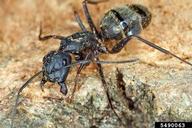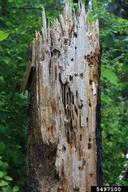The Carpenter Ant … more friend than foe


Carpenter ants are distinctively large, black ants.
Sawdust … you find a pile in a cupboard or by a baseboard in your home. Outside you see a hole (or more) in your tree and discover sawdust piling up on the ground below. A reason to panic? Not at all.
The first question I get from homeowners is, do I have termites? If you have sawdust, no. You have carpenter ants.
And they are not the problem. You should actually thank them. You don’t realize it, but they are really little home inspectors and unofficial arborists alerting you that you have rotting wood somewhere.
Sometimes you may not see the ants but only sawdust, or conversely, see the ants but no sawdust. So what do carpenter ants look like? Can you recognize them by the little yellow hard hats and vests they wear and the tools they carry? Uh, no. I was just checking to see if you were still with me. Although I do envision them wearing these outfits. (OK I have a wild entomological imagination).

Carpenter ant damage in trees isn’t the cause of a problem; they smell rotting wood and come to it.
Carpenter ants are large black ants; they can also be black with brownish copper abdomens. Carpenter ants are 3/8” to ½” long. They are the largest ants we have in Northern Illinois. Sometimes you will find them with wings; sometimes without, queens and male ants can have wings.
There are three identifying features that clearly define termites vs ants (any ants): The easiest one you can usually observe without much squinting, or your glasses is the body parts. Ants all look like they are made up for three connected, but separate balls-head, chest (thorax) and abdomen. Termites are different — their bodies are pear-shaped, with a little ball head.
Second, look at the antennae. Termites have straight antennae; ants have elbowed antennae. Ant antennae form an L-shape. And finally, look at the wings. If you see ant-like insects with wings, look at the wing length. Ants have one large/long and one small wing on each side. Termites have equidistant wings, meaning all of the four wings are the same length.
You might find it surprising, but carpenter ants are not considered a significant, structural pest. Carpenter ants excavate the rotted part of wood, whether in a living tree or lumber-and spit it out, hence the sawdust. They create their home (called galleries) in the newly cleaned out area.
Termites on the other hand actually eat wood — healthy wood. They chew it up like carpenter ants, but instead of spitting it out, termites have gut microbes that digest the wood, and the wood is broken down enough to be absorbed and utilized. Termite “leftovers” look more like the ubiquitous dust bunny that I am sure you don’t have at your house but have seen at someone else’s. It is an airy puffball, not a pile of wood shavings.
The remaining part of the wood after a termite has had its way, is just paper … think layers of grain. It almost looks like feathers. And there is no structure left to the wood. That is why termites are an important structural pest of wood.
Carpenter ants are drawn only to rotting wood and will seek it out, inside or out. Humans, we can’t smell rotting wood (unless up close and personal), so our little carpenter ant friends are doing us a favor. Typically inside, rotting wood is found if you have either damage from a winter ice dam where the gutters freeze and the thawing ice has nowhere to go as it melts, so it comes inside, or you have a plumbing leak somewhere behind a wall.
So you think, “I’ll just get on the ol’ ‘spray’” — feeling self-assured that you will solve the problem by eradicating them. You won’t, because as long as you have that rotten wood situation, more carpenter ants will be on their way. So, no spray; look for the real problem. Fix the rotting wood. Only then will your carpenter ant problem be solved.
Outside presence of carpenter ants is somewhat a different story. Yes, the carpenter ants are still seeking out rotting wood, but this is a good thing. The carpenter ants are doing some well-needed housekeeping.
By cleaning out the rot to set up their own homestead, they are removing the rot, which helps the tree actually last longer.
But when you see carpenter ant activity in your trees, whether in an old tree where the natural rotting from the inside out process has begun, or tree rot that has occurred to do poor pruning (topping) or injury, it is good to have the tree evaluated by an arborist periodically.
They can take a core sample to see how much wood remains in the trunk and ascertain if the tree is still structurally sound. It may be hard to believe, but when you hear of what looks like a perfectly healthy tree, with a full crown of leaves, suddenly fall down on a windless day, it is usually that the trunk has rotted out to a point where the weight of the leaves actually pull the tree down.